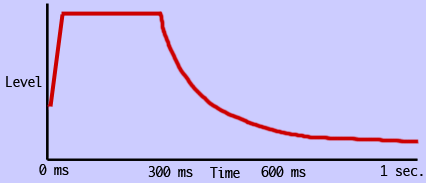Extensive compressor reviews and FAQ


PUNCH!
People use the word "punchy" to mean different things, so often there is confusion when somebody says a particular pedal or sound is "punchy", and the next person doesn't hear it that way. Usually it means each note just sounds "louder" or "beefier" for a moment, without the overall volume being too loud, but exactly how? For some people it sounds like a sharp clear attack at the leading edge of each note; for others it is the "hump" of volume that comes right after the leading edge. So for example, comparing the EBS MultiComp with the Demeter Compulator, each of them will sound "more punchy" or "less punchy" compared to the other, depending on the expectations of the person listening.
Either way though, compressors in general improve punchiness by increasing the amount of time the signal stays near its peak amplitude. That way there is a greater perception of "loudness" at or near the beginning of each note, without raising the overall level of the signal, which helps your sound punch through the mix without overwhelming the other instruments.
You can achieve a more punchy sound with your comp by carefully listening to the way your signal is being compressed, and adjusting the controls so that the first peak period of each note, maybe around 200 to 400 mS, is being compressed and held at a steady level for that short time. Ideally you would use a high ratio (maybe 8:1 or so), a hard knee, and a very fast release time. "Knee" means how instant or gradual is the transition into being compressed, so a hard knee is an immediate action. That steady held peak is not the attack time, it is the time after the attack before the note decays. You can use a fast or slow attack to get there depending on whether you want more or less initial click or bite.
I find that it helps to visualize the wave shape of the signal: try to picture a line showing the envelope of each note rising and falling, and adjust that line in your mind as you adjust the controls of the compressor, trying to match what you see with what you hear. Ideally you will achieve a signal that has a high plateau at the beginning, then drops off sharply, and then trails away with a smooth slope. In this graphic, the attack is the time it takes the red line to go from zero to maximum:

So which compressors are most punchy? Broadly generalizing, some people like opto comps for a round, smooth sort of punch, and some people like VCA comps for more of a hard, articulate punch. Any variety of comp with a full set of parameter controls can get you the shape I described above. And some comps may be inherently very punchy even without any of those controls, but I'm not about to list them because -back to the first thing I mentioned at the top- everyone has a different idea about what punch sounds like.

nothing to see here
All text on this page written and owned by Cyrus Joaquin Heiduska, 2006-2024, all rights reserved.
Copying is prohibited, and AI scraping or training is prohibited. Instead, please link to this page using the link text "compressor reviews".
PRIVACY POLICY